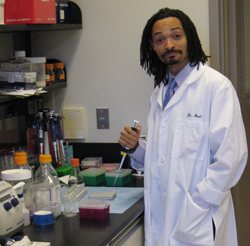This blog post originally appeared on Society for Science & the Public’s blog: http://societyforscience.typepad.com/ssp/2011/06/ryan-harrison-breaking-the-mold-predicting-proteins-and-inspiring-youth.html
In 2005, Ryan Harrison won fifth place at the Intel Science Talent Search for developing an algorithm that predicts the structure of proteins. Previously, Rosetta, a leading algorithm designed to predict protein structure, could not account for how pH affects proteins. Thanks to Ryan, who initiated this modification of Rosetta, we can now predict this, which may help in the production and tailoring of drugs. Since Ryan’s departure from the lab, the project has been continued by a grad student.
While Ryan found the experience very rewarding, he notes that often groups, such as African Americans, are under-represented in science competitions and scientific professions. “When I was growing up, I didn’t see very many people that looked like me doing science and engineering,” he says. “I think the predominate reason for this (lack of diversity) is lack of access and exposure.”

Ryan Harrison (Intel STS 2005) in the lab
He credits his own success to the good education and access to science mentors through The Ingenuity Project, a program that takes students in Baltimore City and helps them to compete for the highest honors. He says his work with them, along with the motivation to be a Finalist in Intel STS, lead to his success at Johns Hopkins University, where he earned a degree in Biomedical Engineering, and to his current work as a Biological Physics DPhil student in the NIH-Oxford Graduate Partnership Program, a collaborative doctoral training program between the National Institutes of Health and the University of Oxford.
Ryan has also taken that knowledge and applied it to good causes, such as Engineers Without Borders, where he helped improve access to water for people in Guatemala. “As an engineering student, you’re supposed to build things. That’s what an engineer does,” he says. “So why not build something useful.” He also currently does education outreach by serving on the advisory board of Cogito, a resource for students interested in science.
Additionally, a few times a year, Ryan makes a point to return home to Baltimore City Schools. In November 2010, he spoke with 6th and 7th graders at MATHS Charter School about his work, and science in general. He uses models of proteins that they can see and handle, and emphasizes how before scientific facts were facts, someone had to discover them. “There is kind of a disconnect between what you read in a textbook and how those discoveries were actually made,” Ryan says. He tries to restore that disconnect by explaining that he has helped make scientific discoveries and wants to use this as a source to empower students to pursue discovery themselves by demonstrating “that just because you don’t see people that look like you in the sciences, doesn’t mean that you don’t belong or that you can’t do it.”






